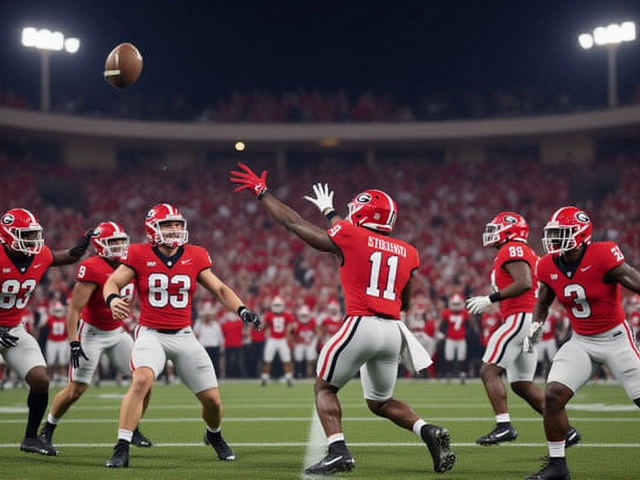For the third week in a row, The Ohio State University Buckeyes sit atop the College Football Playoff rankings, holding a perfect 10-0 record as the committee unveiled its third set of standings on Tuesday, November 18, 2025. The announcement, made live from the College Football Playoff headquarters in Irving, Texas, confirmed what many suspected: the Buckeyes remain the clear favorite to reach the national championship. But the real story wasn’t just Ohio State’s dominance—it was the razor-thin margin separating the playoff field from heartbreak. The cutoff? No. 10. And the implications? Chaos.
The Top Five: A Battle of Perfection
Indiana University Hoosiers (11-0) climbed to No. 2, their unblemished record earning them the most coveted spot behind Ohio State. Texas A&M University Aggies (10-0) held firm at No. 3, while University of Georgia Bulldogs (9-1) slipped to No. 4 despite a strong season—largely because of Alabama’s head-to-head win over them. Texas Tech University Red Raiders (10-1) surprised many by cracking the top five, thanks to a late-season surge and a signature win over Oklahoma. Analyst Booger McFarland put it bluntly: “Assume that Alabama by virtue of that head-to-head win against Georgia and the hot streak the Tides been on since then will be at four and they are.”The Playoff Bracket: A Minefield of Upsets
The committee didn’t just rank teams—they laid out the entire 12-team bracket, and it’s a minefield. No. 12 Tulane University Green Wave (8-2) will travel to face No. 5 Texas Tech, with the winner advancing to play No. 4 Georgia. Meanwhile, No. 9 University of Notre Dame Fighting Irish heads to No. 8 University of Oklahoma Sooners in what could be a shootout. The real drama? No. 10 University of Alabama Crimson Tide (8-2) gets a home game against No. 7 University of Oregon Ducks. Win that, and Alabama’s path to the title looks wide open. Lose? Their season ends in Glendale.Conference Champions Get a Free Pass—Even If They’re Ranked 13th
Here’s the twist: you don’t need to be top 10 to make the playoff. The five highest-ranked conference champions get automatic bids, regardless of overall record. That’s why University of Miami Hurricanes (8-2, ACC champions), ranked No. 13, are in. And why Brigham Young University Cougars (9-1, Big 12), the highest-ranked team left out, is watching from home. Greg McElroy summed it up: “You don’t have to win your conference championship in order to get a bid, but the five highest-ranked conference champions, regardless of which conference they come from, get into the field.”
The Big Fall: Virginia’s Five-Spot Plunge
No team tumbled harder than University of Virginia Cavaliers (9-2). After a close win over Louisville, they were sitting pretty at No. 14. Then came the loss to Wake Forest—a game analysts called “a classic ACC trap.” They dropped five spots to No. 19. “That’s another thing to think about,” McElroy said, shaking his head. Virginia still had the head-to-head edge over Louisville, but the committee values momentum more than history. Their final game against Duke? A must-win just to stay in the conversation for a New Year’s Six bowl.Group of Five Breakthrough: USF Makes History
For the first time this season, a Group of Five team cracked the rankings: University of South Florida Bulls. They weren’t ranked last week. Now they’re in. It’s a sign the committee is paying attention to more than just Power Five programs. Meanwhile, North Texas Mean Green (9-1, AAC), though not in the top 25, got a shoutout for freshman running back Caleb Hawkins, who set a school record with five rushing touchdowns against UAB. He now has 16 for the season—tied for the national lead.
What’s Next? Two Weeks of Pure Pressure
The next rankings drop on November 25, 2025. But the real drama unfolds in the final weekend of the regular season. Virginia vs. Duke. Alabama vs. Oregon. Indiana’s showdown with Purdue. Ohio State’s finale against Michigan. One slip, and a team’s entire season can unravel. And with the final playoff selections locked in on December 7, 2025, every snap matters. The semifinals? January 2, 2026, at the Cotton Bowl in Arlington, Texas and the Fiesta Bowl in Glendale, Arizona. The title game? January 12, 2026, at Mercedes-Benz Stadium in Atlanta.Why This Matters
This isn’t just about who makes the playoff. It’s about how the system works—and who it favors. The 12-team format was supposed to be fairer. But the automatic bids for conference champs, combined with the committee’s emphasis on strength of schedule and late-season momentum, still create winners and losers. Teams like BYU and Utah, both with nine or more wins, are left out while Miami sneaks in. That’s not chaos. That’s policy.Frequently Asked Questions
How did Miami make the playoff despite being ranked No. 13?
Miami earned an automatic bid as the fourth-highest-ranked conference champion (ACC), even though they’re ranked 13th overall. The 12-team playoff rules guarantee five automatic spots to the top five conference champions, regardless of overall ranking. That’s why BYU (9-1, Big 12), ranked higher than Miami, was left out—because they didn’t win their conference.
Why did Virginia drop five spots after losing to Wake Forest?
Virginia’s loss to Wake Forest wasn’t just a defeat—it was a loss to a team that was unranked and coming off a bye week. The committee values momentum, and Virginia’s late-season stumble overshadowed their earlier wins. Even though they held the head-to-head edge over Louisville, the committee prioritized recent performance, and their drop to No. 19 reflects that shift in perception.
Who are the biggest threats to Ohio State in the playoff?
Indiana (11-0) is the only undefeated team left, and their offense has been electric. But Texas A&M (10-0) and Alabama (8-2) are also dangerous. Alabama’s defense has tightened since their early losses, and their win over Georgia gives them a psychological edge. If Ohio State survives Michigan, they’ll likely face either Indiana or Alabama in the semifinals—and both are capable of pulling the upset.
What’s the significance of USF being ranked this week?
The University of South Florida Bulls are the first Group of Five team to crack the rankings this season. It signals the committee is taking non-Power Five programs more seriously—even if they’re not playoff contenders. A ranking like this can boost recruiting, TV deals, and conference prestige. It’s a small step toward equity in a system still dominated by the Power Five.
When will the final playoff bracket be announced?
The final rankings and full playoff bracket will be revealed on Sunday, December 7, 2025, at 12:00 PM Eastern Time. The semifinals are set for January 2, 2026, with the National Championship Game on January 12, 2026, at Mercedes-Benz Stadium in Atlanta. Until then, every game in the final two weeks could change everything.
Why is Texas Tech ranked higher than Alabama?
Texas Tech (10-1) has a stronger overall resume: a win over Oklahoma, a 10-game winning streak, and a higher strength of schedule than Alabama’s 8-2 record. Alabama’s loss to LSU and a weak non-conference schedule hurt them, even though they beat Georgia head-to-head. The committee weights consistency and quality wins more than single victories.




